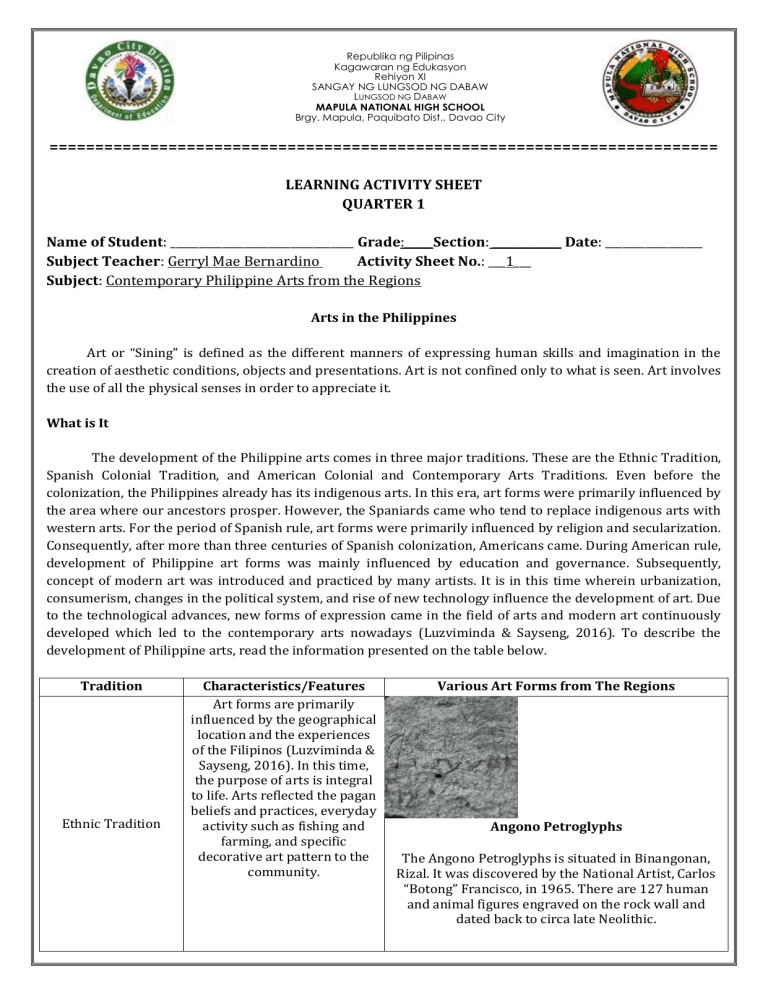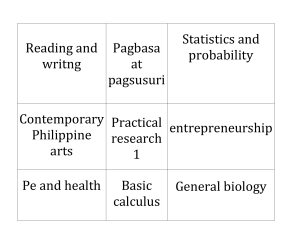
Republika ng Pilipinas Kagawaran ng Edukasyon Rehiyon XI SANGAY NG LUNGSOD NG DABAW LUNGSOD NG DABAW MAPULA NATIONAL HIGH SCHOOL Brgy. Mapula, Paquibato Dist., Davao City ========================================================================= LEARNING ACTIVITY SHEET QUARTER 1 Name of Student: ________________________________ Grade:_____Section: ____________ Date: _________________ Subject Teacher: Gerryl Mae Bernardino Activity Sheet No.: ___1___ Subject: Contemporary Philippine Arts from the Regions Arts in the Philippines Art or “Sining” is defined as the different manners of expressing human skills and imagination in the creation of aesthetic conditions, objects and presentations. Art is not confined only to what is seen. Art involves the use of all the physical senses in order to appreciate it. What is It The development of the Philippine arts comes in three major traditions. These are the Ethnic Tradition, Spanish Colonial Tradition, and American Colonial and Contemporary Arts Traditions. Even before the colonization, the Philippines already has its indigenous arts. In this era, art forms were primarily influenced by the area where our ancestors prosper. However, the Spaniards came who tend to replace indigenous arts with western arts. For the period of Spanish rule, art forms were primarily influenced by religion and secularization. Consequently, after more than three centuries of Spanish colonization, Americans came. During American rule, development of Philippine art forms was mainly influenced by education and governance. Subsequently, concept of modern art was introduced and practiced by many artists. It is in this time wherein urbanization, consumerism, changes in the political system, and rise of new technology influence the development of art. Due to the technological advances, new forms of expression came in the field of arts and modern art continuously developed which led to the contemporary arts nowadays (Luzviminda & Sayseng, 2016). To describe the development of Philippine arts, read the information presented on the table below. Tradition Ethnic Tradition Characteristics/Features Art forms are primarily influenced by the geographical location and the experiences of the Filipinos (Luzviminda & Sayseng, 2016). In this time, the purpose of arts is integral to life. Arts reflected the pagan beliefs and practices, everyday activity such as fishing and farming, and specific decorative art pattern to the community. Various Art Forms from The Regions Angono Petroglyphs The Angono Petroglyphs is situated in Binangonan, Rizal. It was discovered by the National Artist, Carlos “Botong” Francisco, in 1965. There are 127 human and animal figures engraved on the rock wall and dated back to circa late Neolithic. Manunggul Jar Manunggul jar is found in Manunggul Cave, Lipuun Point, Palawan in the early 1960s. Manunggul jar is a burial jar which signifies the belief of early Filipino in life after death. Banga Banga literally means pots. The Banga or pot dance is a performance of Kalinga of the Mountain Province of the Philippines. This dance shows the elegant grace of Igorot tribe and the skill and strength of women. Spanish Colonial Tradition Art forms were primarily influenced by religion and secularization. In this time, Spaniards used arts to propagate the Catholic faith. Langit, lupa, at Impyerno by Josef Luciano Dans This wall painting by Josef Luciano Dans will be found in St. James the Apostle Church in Paete, Laguna. This painting was dated 1850 and depicts the heaven, crucifixion of Christ; earth, Adan and Eve; and hell, sinners with different transgressions. St. Paul Metropolitan Cathedral St. Paul Metropolitan Cathedral is located in Burgos, Vigan City, Ilocos Sur. The original structure was built in 1574 and replaced as a church in 1641. The cathedral follows a Baroque architectural design. Modern Art American Colonial and Contemporary Arts Traditions Modern art refers to the practice of art from 1860s to 1960s. the main theme of art works in this time is national identity. The Making of the Philippine Flag by Fernando Amorsolo This painting was made by Fernando Amorsolo, “Grand Old Man of Philippine Art” and born in Manila. It shows a reminder of the reminder of traditions and customs of the Filipino. Bayanihan by Carlos “Botong” Francisco Carlos “Botong” Francisco was born in Ango, Rizal. This painting by him was dated in 1962. This mural painting of Carlos “Botong” Francisco shows the Filipino’s bayanihan tradition. This also shows the distinctive style of Francisco’s painting that showcased his mastery in arts. Contemporary Arts Contemporary art refers to the practice of art from 1970s to the present. Contemporary arts mirror contemporary culture and society. Diverse and emerging art practices were being introduced in this era. Cinco Marias (Tres Marias Series) by Federico Aguilar Alcuaz Federico Aguilas Alcuaz was born in Santa Cruz, Manila. Cinco Marias (Tres Marias Series) depicts the variety of domestic activities (Guillermo, 2007). Art Installation in Sand Dunes of Paoay by Leeroy New Leeroy New is one of the Philippines contemporary artists. He is born in General Santos City. This art installation of Leeroy New was made for the La Milagrosa Festival in Ilocos Norte. According to Leeroy New, the art installation symbolizes the great festivals, feasts and celebrations (Lape𝑛̃a, 2012). These art forms from various regions or from various artists contributed to the picture of Philippine’s identity as a country. And as a Filipino, it’s important that we have knowledge to describe these art forms based on its details and elements, in relation to our country’s culture and tradition, that makes it an artistic piece. In the field of arts, knowing the elements and principles of arts is important, not just to the artist but also to the viewer, to have a deeper understanding of an artwork. Now, let us know these elements and principles of arts. Activity: Applying Knowledge about Arts Instructions: Read and analyze the following statements. Write ET if the statement describes Ethnic Tradition of Philippine arts, ST if it describes Spanish Colonial Tradition, and ACT if it is American Colonial and Contemporary Arts Traditions on the answer sheet provided. _____ 1) Arts in this period thrived because of the primary influences of our Filipino ancestors. _____ 2) This period mirrors the contemporary culture and society; diverse and emerging art practices were introduced. _____ 3) Arts was used as one of the instruments to propagate the Catholic faith in this era. _____ 4) A practice of art was developed in this period wherein the themes of artworks are about the Philippines' identity. _____ 5) This period reflects the emerging development of Philippine art practices that continue to develop from the 1970s to the present.


